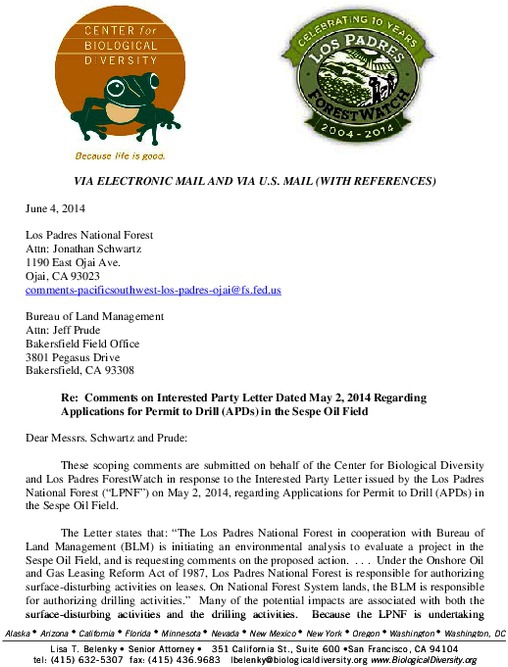From the Open-Publishing Calendar
From the Open-Publishing Newswire
Indybay Feature
Proposed Fracking in California Condor Habitat Draws Protest
GOLETA, Calif.— An oil industry proposal to drill and frack eight new wells and construct thousands of feet of new pipelines in the middle of Los Padres National Forest threatens the California condor and would generate fracking pollution dangerous to human health, two environmental groups said in a letter sent today to forest officials and the federal Bureau of Land Management (see PDF).

In the letter the Center for Biological Diversity and Los Padres ForestWatch point out that the Endangered Species Act and the National Environmental Policy Act require federal officials to take a hard look at fracking pollution’s “potential impacts to resources including wildlife, ground and surface water quality and resources, seismic safety, and air quality.”
“Federal officials can’t just rubber-stamp a plan to drill and frack new oil wells in habitat vital to the California condor, one of the world’s most endangered birds,” said Ileene Anderson, a Center biologist. “The Forest Service must recognize that allowing fracking in Los Padres National Forest puts this amazing area and its imperiled wildlife at risk from petroleum pollution.”
The proposal is the latest effort to expand drilling and fracking in the national forest. A recent ForestWatch investigation of state records revealed that at least 18 wells have been fracked since 2011, on private land intermingled with national forest land in the Sespe Oil Field, without any public notice or environmental analysis of the risks posed by controversial fracking operations — including risks to human health, air and water quality, the California condor, southern steelhead, and other wildlife. Both the BLM and the Forest Service are relying on outdated data to evaluate the risks of oil and gas operations in the Sespe Oil Field.
“Fracking eight wells and constructing two miles of pipeline in an environmentally sensitive area clearly warrants a full, thorough, and careful analysis in an environmental impact statement before moving forward,” said Jeff Kuyper, executive director of Los Padres ForestWatch, a nonprofit organization based in Santa Barbara that monitors fracking and oil drilling throughout Los Padres National Forest. “There’s too much at stake to fast-track fracking in our forest.”
The Sespe Condor Sanctuary, established in 1947, surrounds the oilfield on three sides. The 2,471-acre Hopper Mountain National Wildlife Refuge — a field base of operations for biologists involved with reintroducing condors to the wild — is on the field’s southern boundary. Condors have already suffered from direct impacts of oil wells and pipelines in the area.
A federal judge ruled last year in response to a Center lawsuit that BLM officials broke the law when they leased land in Monterey and Fresno counties to oil companies without studying the possible risks of fracking.
Despite new state rules that were supposedly going to impose more transparency on the industry, a recent Center analysis found that Californians still aren't being informed about fracking and other dangerous forms of oil extraction in their communities and wild areas. Oil companies using fracking and other extreme techniques in Los Angeles and Orange County have employed millions of pounds of formaldehyde and other dangerous "air toxic" chemicals in recent months, according to South Coast Air Quality Management District data.
The Center for Biological Diversity is a national, nonprofit conservation organization with more than 775,000 members and online activists dedicated to the protection of endangered species and wild places.
Los Padres ForestWatch is a local nonprofit conservation organization working to protect wildlife, wilderness landscapes, and the great outdoors in the Los Padres National Forest and other public lands along California’s Central Coast.
June 4, 2014
http://www.biologicaldiversity.org/news/press_releases/2014/los-padres-national-forest-06-04-2014.html
http://www.biologicaldiversity.org/
“Federal officials can’t just rubber-stamp a plan to drill and frack new oil wells in habitat vital to the California condor, one of the world’s most endangered birds,” said Ileene Anderson, a Center biologist. “The Forest Service must recognize that allowing fracking in Los Padres National Forest puts this amazing area and its imperiled wildlife at risk from petroleum pollution.”
The proposal is the latest effort to expand drilling and fracking in the national forest. A recent ForestWatch investigation of state records revealed that at least 18 wells have been fracked since 2011, on private land intermingled with national forest land in the Sespe Oil Field, without any public notice or environmental analysis of the risks posed by controversial fracking operations — including risks to human health, air and water quality, the California condor, southern steelhead, and other wildlife. Both the BLM and the Forest Service are relying on outdated data to evaluate the risks of oil and gas operations in the Sespe Oil Field.
“Fracking eight wells and constructing two miles of pipeline in an environmentally sensitive area clearly warrants a full, thorough, and careful analysis in an environmental impact statement before moving forward,” said Jeff Kuyper, executive director of Los Padres ForestWatch, a nonprofit organization based in Santa Barbara that monitors fracking and oil drilling throughout Los Padres National Forest. “There’s too much at stake to fast-track fracking in our forest.”
The Sespe Condor Sanctuary, established in 1947, surrounds the oilfield on three sides. The 2,471-acre Hopper Mountain National Wildlife Refuge — a field base of operations for biologists involved with reintroducing condors to the wild — is on the field’s southern boundary. Condors have already suffered from direct impacts of oil wells and pipelines in the area.
A federal judge ruled last year in response to a Center lawsuit that BLM officials broke the law when they leased land in Monterey and Fresno counties to oil companies without studying the possible risks of fracking.
Despite new state rules that were supposedly going to impose more transparency on the industry, a recent Center analysis found that Californians still aren't being informed about fracking and other dangerous forms of oil extraction in their communities and wild areas. Oil companies using fracking and other extreme techniques in Los Angeles and Orange County have employed millions of pounds of formaldehyde and other dangerous "air toxic" chemicals in recent months, according to South Coast Air Quality Management District data.
The Center for Biological Diversity is a national, nonprofit conservation organization with more than 775,000 members and online activists dedicated to the protection of endangered species and wild places.
Los Padres ForestWatch is a local nonprofit conservation organization working to protect wildlife, wilderness landscapes, and the great outdoors in the Los Padres National Forest and other public lands along California’s Central Coast.
June 4, 2014
http://www.biologicaldiversity.org/news/press_releases/2014/los-padres-national-forest-06-04-2014.html
http://www.biologicaldiversity.org/
Add Your Comments
Latest Comments
Listed below are the latest comments about this post.
These comments are submitted anonymously by website visitors.
TITLE
AUTHOR
DATE
STOP DESTROYING OUR WORLD
Sat, Jun 20, 2015 6:45AM
We are 100% volunteer and depend on your participation to sustain our efforts!
Get Involved
If you'd like to help with maintaining or developing the website, contact us.
Publish
Publish your stories and upcoming events on Indybay.
Topics
More
Search Indybay's Archives
Advanced Search
►
▼
IMC Network



